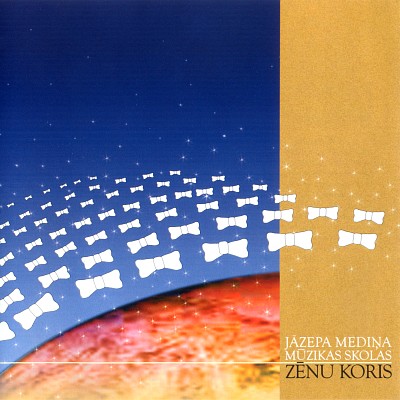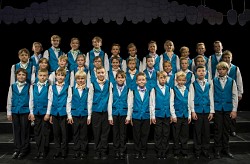2003 - What a Wonderful World

Artist: Jāzepa Mediņa mūzikas skolas zēnu koris
Format: CD
© 2003 Baltic Records Group
© 2005 Zyx Classics
1. What a Wonderful World - G.D.Weiss - B.Thiele / arr. by P.Matsson
2. Ticība - H.Pavasars - J.Poruks
3. Madrigāls pie četrām svecēm - M.Zariņš - E.Ādamsons
4. April is in my Mistress' face - T.Morley
5. Chi la gagliarda - B.Donati
6. Je ne fus jamais si aise - P.Certon play
7. Zigeunerleben - R.Schumann - E.Geibel
8. Tshotsholosa - South African freedom song play
9. Gabi, Gabi - South African freedom song
10. Siyahamba - South African freedom song
11. Kur tad tu nu biji? - Latvian folksong / arr. by R.Pauls
12. Man jāiet čigānos - Latvian folk materials / arr. G.Gedulis
13. Ai, nama māmiņa - Latvian folksong / arr. by A.Jansons
14. Alegres pregonan - Venezuelian Christmas song / arr. by V.E.Sojo
15. White Christmas - I.Berlin / arr. by S.Eielsen
16. Jingle Bells - J.S.Pierpont
17. Praise His Holy Name - K.Hampton
18. Clap Yo' Hands - G.Gershwin - I.Gershwin / arr. by P.King
The bright angels, the winged messengers of song, so young yet miraculously coping with their music sheets. Such and like ideas will make the audience's (by and large representing the age group of grandmas and mamas) eyes wet with tears, and will inspire and cheer. In reality, however, it is different. The members of boys' choirs are regular, indeed commonplace boys. Their lives are about (a lot of) studying, (a tiny little bit of) leisure, sometimes knocking about and always getting excited. Some of them are composed and clever, some unyielding and intractable, there are some bright minds and some windbags, there is always someone who reports and someone who sulks.2. Ticība - H.Pavasars - J.Poruks
3. Madrigāls pie četrām svecēm - M.Zariņš - E.Ādamsons
4. April is in my Mistress' face - T.Morley
5. Chi la gagliarda - B.Donati
6. Je ne fus jamais si aise - P.Certon play
7. Zigeunerleben - R.Schumann - E.Geibel
8. Tshotsholosa - South African freedom song play
9. Gabi, Gabi - South African freedom song
10. Siyahamba - South African freedom song
11. Kur tad tu nu biji? - Latvian folksong / arr. by R.Pauls
12. Man jāiet čigānos - Latvian folk materials / arr. G.Gedulis
13. Ai, nama māmiņa - Latvian folksong / arr. by A.Jansons
14. Alegres pregonan - Venezuelian Christmas song / arr. by V.E.Sojo
15. White Christmas - I.Berlin / arr. by S.Eielsen
16. Jingle Bells - J.S.Pierpont
17. Praise His Holy Name - K.Hampton
18. Clap Yo' Hands - G.Gershwin - I.Gershwin / arr. by P.King
Their teachers are armed with patience and endurance, and an accurately balanced judgment as to exactly when it is time for a thrashing or a well-measured praise. For one thing, the boys have good, some even very good voices, and this is why the sound is measured in immaterial categories like "angelic". In musical terminology it is referred to as "treble". No other instrument may be so sincere: it openly confesses when it is about to fail, however, it is in control when it surrenders, when it breaks into blossom yielding supple brightness, and then we are in for a happy hour.
The boys' choir of Jazeps Medins music school was established in 1981. Under the artistic leadership of Romans Vanags (since 1987), it has succeeded in defining the basic lines of its characteristic musical and human code. One that we shall not be able to quote since it has never been written, but anyone who will get into a close contact with the choir, will soon understand the name of the game and become an insider, once ready to embrace the world, adventure and music. The Medins school students' routine is studying regular subjects and music, and it is rewarded through concerts and records. Two of their albums are dedicated to the so-called serious music, but others have been recorded in cooperation with Latvian pop stars like Marija Naumova, Niks Matvejevs and the "Bet Bet" rock group. Extraordinarily warm sound and tender expression are the most outstanding qualities of the choir.
Time after time during the last 15 years the managers have endeavoured to move the uncontrollable mass which is a boys' choir, across the borders of the country. Ever since Latvia's third Awakening, and after that tours were mapped to Estonia, Russia, Poland and Germany, then, in response to an initiative from Latvians in exile, the boys travelled to the Northern parts of the USA. (1990) and UK (1991/92). Those were followed by laurels at the Nantes competition for children's choirs (1993), the Australian tour (1995), several tours to the USA. and Canada, the second prize at the prominent Arezzo competition, as well other nice trips including singing visits to exotic countries like Brazil (1998/99), South Africa (1999) and Venezuela (2002). Christmas and New Year were often celebrated on the road, therefore melodies dedicated to the birth of Jesus Christ have place in the new album: the legendary "White Christmas" by Irving Berlin and Jingle Bells" arranged by the Blues giant Ray Charles (although composed in the 19th century for the Thanksgiving Day, this probably is one of the first Christmas songs ever written in America). The ethnic aspect of the winter solstice, in the form of the mummers' activities, has been contemplated in the arrangements by Andrejs Jansons, the New York based composer and conductor and Guntars Gedulis from Venezuela.
In one way or another, other songs too have connexion to the choir's travels. Vicente Emilio Sojo, the forefather of the 20th century's Venezuelan composers is represented in the album. There are songs of freedom from the South African repertoire, like "Gabi Gabi" (Let us get together in a movement and fight), "Siyahamba" (We act in the light of God), and "Tshotsholoza" (This train comes across the mountains). The travellers across Europe choose to focus on the music of the previous centuries: the Renaissance galliard by Venetian Baldasare Donatti reminds of the fact that Elizabeth I, the Ruler of the Chapel Royal gentleman Thomas Morley, had the habit of doing her morning exercises to the rhythm of the the question where we are going tomorrow.
The Medins School choir boys sing of everything in their world travel album, and all this diversity has a common denominator, the super-hit "What A Wonderful World" by George David Weiss. It is under this title that the world will get their Christmas songs, mummers' songs, madrigals and un gospels, this is how they fight for freedom and how they celebrate the last glowing log in a campfire at the edge of a wood, and at the end of the day even the thrashing the naughty goat gets for stealing is not too bad. What a wonderful world: normal regular chaps do extraordinary work, and their teachers are very special and very special is the album itself.
Amazon.com
Hmv.co.jp
